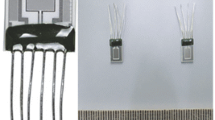Abstract
WHEN a nearly saturated solution of lauric acid in distilled water is placed in an Adam-Jessop film-pressure trough, the soluble adsorbed film may be compressed or swept in the same manner as an in soluble film of a higher fatty acid. However, the surface is rapidly replenished by diffusion from below, after sweeping, or the compressed film diffuses down-ward. In either case the reading of the film-balance returns to zero, in a period of about thirty minutes at 25° C. Similar effects have been noticed with benzopurpurin solutions1 and with soap solutions2. Since the contact potential of solutions is proportional to the concentration of the surface-active solute, simultaneous contact potential measurements with a polonium-covered silver electrode on the above surfaces might be expected to yield potential-time curves nearly parallel to the force-time curves. Such proved to be the case, with the following notable differences.
Similar content being viewed by others
References
Doss, Current Sci., 4, 405 (1935).
McBain and Wilson, private communication, and J. Amer. Chem. Soc., 58, 379 (1936).
J. Chem. Phys., 1, 852 (1933).
Ann. Phys., x, 15, 5 (1931).
Author information
Authors and Affiliations
Rights and permissions
About this article
Cite this article
FLORENCE, R., MYERS, R. & HARKINS, W. Contact Potentials of Reversible Soluble Films of Lauric Acid. Nature 138, 405–406 (1936). https://doi.org/10.1038/138405b0
Issue Date:
DOI: https://doi.org/10.1038/138405b0
- Springer Nature Limited
This article is cited by
-
Oberflächenfilme von Bromphenolblau
Kolloid-Zeitschrift (1952)





